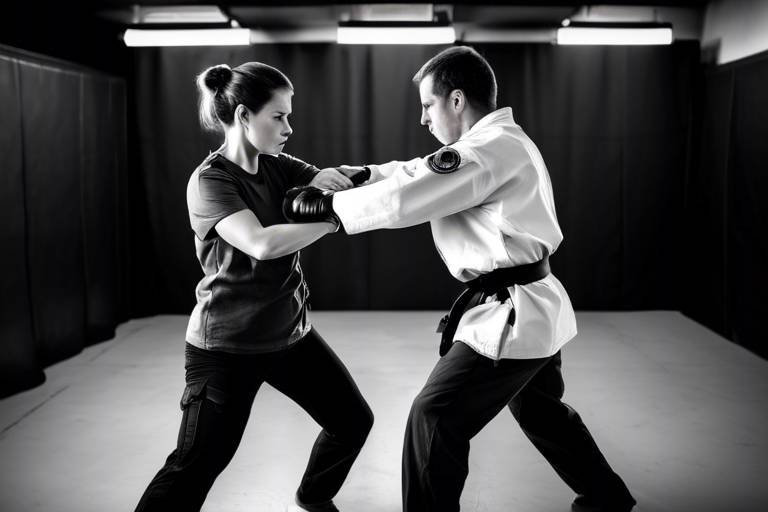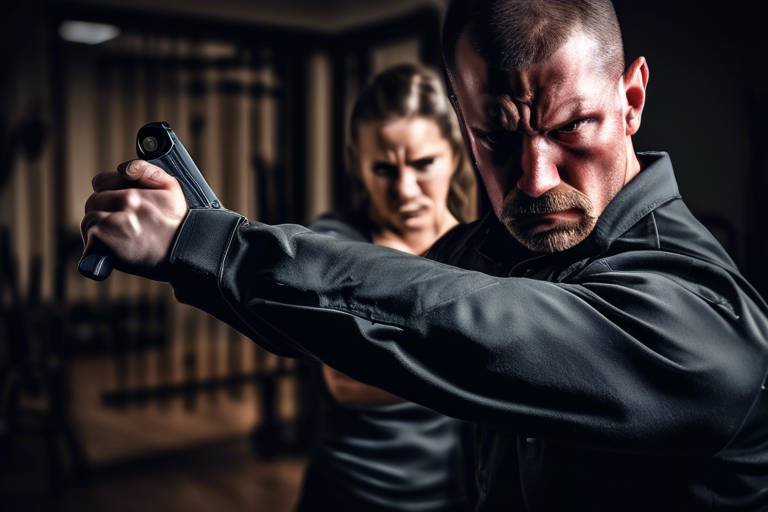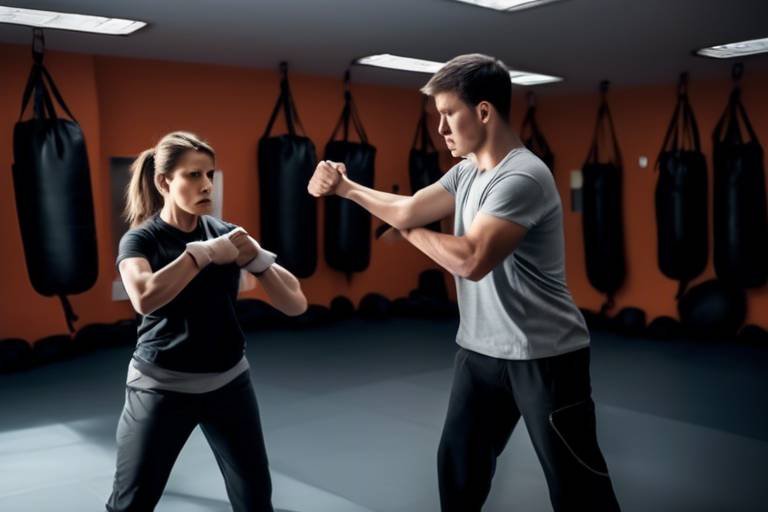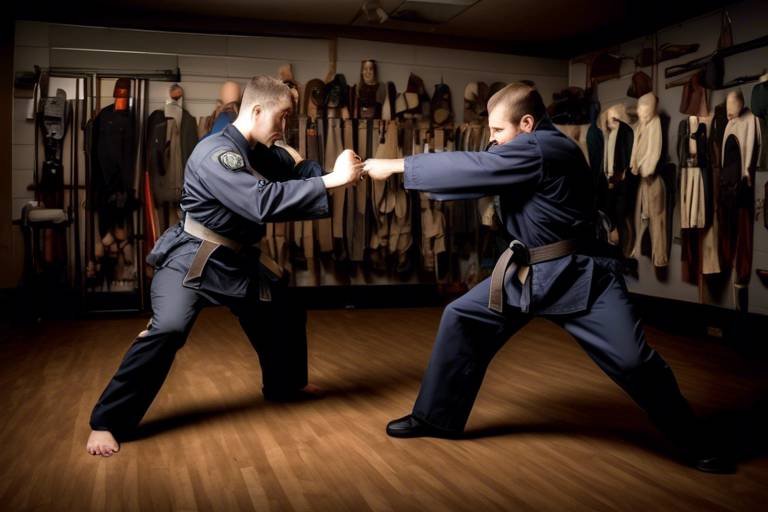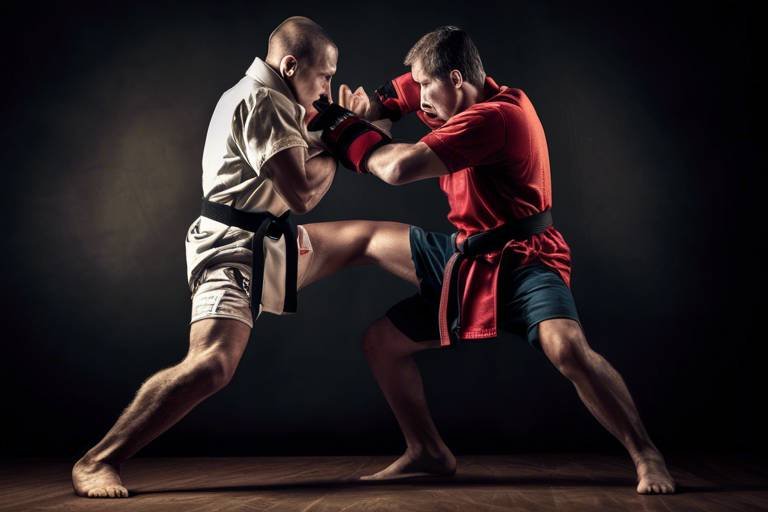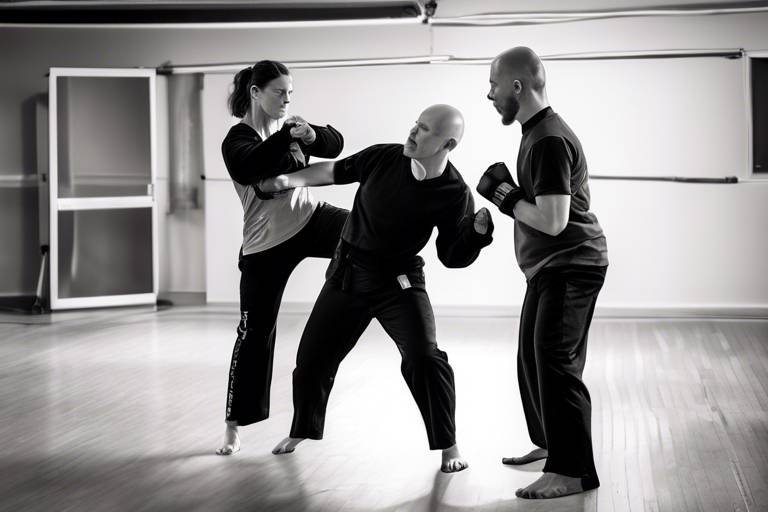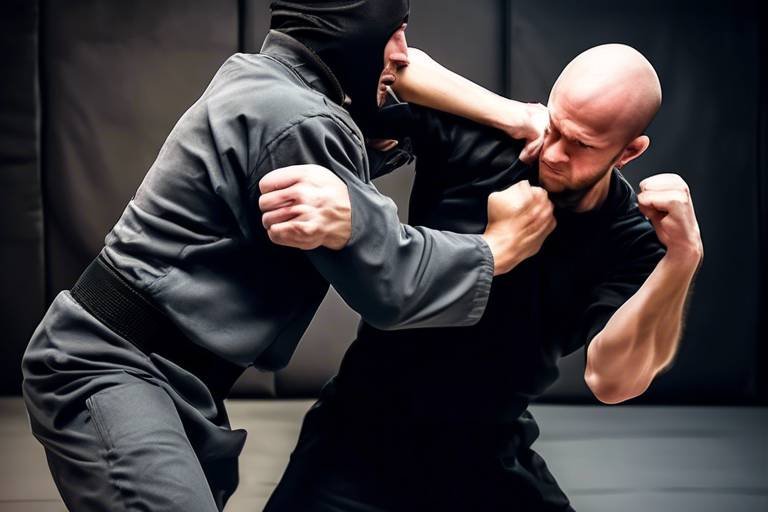Effective Self Defense Techniques for Women
In today's world, the importance of self-defense cannot be overstated, especially for women. With the rise in awareness regarding personal safety, it's crucial to equip oneself with effective self-defense techniques that not only empower but also instill a sense of confidence. Imagine walking down the street, feeling secure and aware of your surroundings, ready to handle any situation that may arise. This article explores essential self-defense techniques specifically designed for women, focusing on practical skills, mental preparedness, and situational awareness to enhance personal safety in various environments.
Self-defense empowers women to protect themselves against potential threats. It's not just about physical confrontation; it's about the mental fortitude that comes with knowing you have the skills to defend yourself. Recognizing the significance of these skills can boost confidence and foster a sense of security in everyday life. When women feel safe, they can navigate their environments with ease, whether it's walking home at night or traveling alone. This sense of empowerment can transform the way women interact with the world, making them more assertive and aware of their surroundings.
Learning fundamental self-defense moves can provide women with the tools to respond effectively to physical confrontations. These techniques emphasize simplicity and practicality, ensuring they can be executed under stress. The beauty of these techniques lies in their accessibility; they can be learned by anyone, regardless of physical fitness or prior experience. Just like learning to ride a bike, once you grasp the basics, you can build upon them and develop your skills further. It's about creating a personal arsenal of techniques that can be adapted to various situations.
Striking techniques, such as punches and kicks, are vital for self-defense. Understanding how to deliver powerful strikes can help women create distance from an attacker and escape dangerous situations. Think of your body as a weapon; when used correctly, it can deliver a powerful blow. A well-placed strike can be the difference between evading danger and becoming a victim. Moreover, practicing these techniques regularly can enhance muscle memory, allowing for quicker responses in high-pressure situations.
Focusing on vulnerable areas of an attacker's body, such as the eyes, throat, and groin, increases the effectiveness of strikes. This knowledge can significantly enhance a woman's ability to defend herself. For instance, a swift jab to the eyes can temporarily blind an assailant, giving you precious seconds to escape. Similarly, targeting the throat can disrupt an attacker's breathing, allowing you to create distance. Remember, it’s not about size or strength; it’s about strategy and precision.
Leveraging body weight in strikes and movements can amplify the impact of self-defense techniques. Learning to use one's body effectively can make a significant difference in a confrontation. Imagine using your hips to generate power in a kick or your shoulders to add force to a punch. It’s all about mechanics; when you understand how to harness your body’s natural strength, you become a formidable opponent. This principle is akin to a well-executed dance move; when you flow with your body's movements, you can achieve greater impact.
Escape strategies are crucial for self-defense, emphasizing the importance of avoiding confrontation whenever possible. Knowing when and how to escape can be the key to personal safety. It's essential to remember that self-defense is not just about fighting back; often, the best defense is to get away from the situation entirely. This might involve creating a diversion, using your environment to your advantage, or simply running away. The goal is to prioritize your safety and well-being above all else.
Situational awareness involves being conscious of one's surroundings and recognizing potential threats. Developing this skill can help women identify and avoid dangerous situations before they escalate. Just like a hawk scans the ground for movement, women must learn to observe their environment and the people within it. This heightened awareness can provide early warning signs and enable proactive decision-making, helping to avoid dangerous encounters altogether.
Understanding warning signs of danger can empower women to take preventive measures. This knowledge allows for proactive decision-making in potentially threatening environments. For example, if someone is following you or if a situation feels off, it's crucial to trust those instincts. Recognizing these signs can be the first step in avoiding a potential confrontation. It's like having an internal alarm system that alerts you to danger before it becomes a reality.
Trusting one's instincts is vital in self-defense. Women should learn to listen to their gut feelings and act accordingly to ensure their safety in various situations. Often, our instincts can sense danger before our conscious mind registers it. This instinctual awareness is a powerful tool; when honed, it can guide women to make safer choices. Just like a compass points north, trusting your instincts can help you navigate through potentially perilous situations.
- What are the best self-defense classes for beginners? Look for classes that focus on practical techniques, such as Krav Maga or Brazilian Jiu-Jitsu, which emphasize real-world scenarios.
- How can I practice self-defense at home? You can practice striking techniques against a punching bag or even shadowboxing to improve your skills.
- Is self-defense training only for women? No, self-defense training is beneficial for everyone, regardless of gender, age, or fitness level.
- How important is physical fitness for self-defense? While being fit can enhance your performance, effective self-defense techniques can be learned and applied by anyone, regardless of fitness level.

Understanding the Importance of Self Defense
Self-defense is not merely a set of physical skills; it is a powerful tool that empowers women to take control of their safety and well-being. In a world where threats can emerge unexpectedly, knowing how to defend oneself can be a game-changer. It’s about more than just fighting back; it’s about cultivating a sense of confidence and security that permeates every aspect of life. When women learn self-defense techniques, they not only gain the ability to protect themselves but also enhance their overall mental resilience.
Consider this: how would you feel walking down a dimly lit street at night, knowing you have the skills to protect yourself? That feeling of empowerment can transform your daily experiences. Self-defense training helps women develop a proactive mindset, where they are not just reacting to threats but actively avoiding them. This mental preparedness is as crucial as physical skills. Imagine being able to walk into any environment with the assurance that you can handle whatever comes your way. This isn’t just about physical safety; it’s about living freely without the constant weight of fear.
Moreover, self-defense training often fosters a sense of community among women. When women come together to learn these skills, they build supportive networks that extend beyond the training room. This camaraderie can lead to lasting friendships and a shared commitment to personal safety. The importance of self-defense is also reflected in its ability to raise awareness about personal safety issues. By engaging in self-defense classes, women become more informed about their surroundings and the potential dangers that exist. This heightened awareness can be a crucial factor in preventing dangerous situations before they escalate.
In addition, self-defense classes often teach practical skills that can be applied in everyday life. For instance, participants learn how to read body language, recognize warning signs of potential threats, and respond appropriately. These skills can be invaluable, as they enable women to navigate their environments with greater confidence and awareness. Ultimately, understanding the importance of self-defense is about embracing a lifestyle of safety and empowerment. It’s about taking charge of your life and ensuring that you have the tools necessary to protect yourself when it matters most.

Basic Self Defense Techniques
When it comes to self-defense, having a few basic techniques under your belt can make a world of difference. Think of these techniques as your personal safety toolkit, ready to be deployed when necessary. The beauty of these moves is their simplicity and effectiveness, designed for anyone to learn and apply, regardless of size or strength. The key is to practice these techniques regularly, so they become second nature when you need them the most.
One of the most effective ways to empower yourself is by mastering striking techniques. These include punches, kicks, and elbow strikes that can create enough distance between you and an attacker, giving you the chance to escape. For instance, a well-placed punch to the nose can disorient an assailant, while a swift kick to the groin can incapacitate them momentarily. The goal here is not to engage in a fight but to create an opportunity for you to get away safely. Remember, self-defense is about survival, not combat.
Now, let’s dive deeper into the art of targeting vulnerable areas. Understanding where to strike can significantly increase your chances of success. Here are some critical areas to focus on:
- Eyes: A quick jab or poke can cause temporary blindness.
- Throat: A strike here can disrupt breathing and buy you precious seconds to escape.
- Groin: A kick or strike can incapacitate an attacker, allowing you to flee.
In addition to targeting vulnerable areas, it’s essential to learn how to leverage your body weight effectively. Many women underestimate their strength, but by using your entire body to execute strikes, you can amplify the impact. For example, when delivering a punch, pivot your hips and shoulders to generate more power. This technique is similar to how a baseball player swings a bat; it’s not just about arm strength, but the whole body working together to deliver a powerful hit.
Another crucial aspect of self-defense is developing escape strategies. The best fight is often the one you avoid, so knowing how to escape a potentially dangerous situation is vital. This could mean identifying exits in a room, being aware of your surroundings, or even practicing how to break free from holds. For instance, if someone grabs your wrist, a simple twist and pull can free you, especially if you step back with your body weight. Always remember that the goal is to get to safety, not to win a fight.
In conclusion, these basic self-defense techniques serve as a foundation for personal safety. By combining striking techniques, targeting vulnerable areas, leveraging body weight, and having a solid escape strategy, you can significantly enhance your ability to protect yourself. Practice regularly, stay aware of your surroundings, and most importantly, trust your instincts. With these tools in your arsenal, you’ll not only feel empowered but also prepared to face any challenges that come your way.
Q: Can anyone learn self-defense techniques?
A: Absolutely! Self-defense techniques are designed for everyone, regardless of fitness level or experience. With practice, anyone can become proficient.
Q: How often should I practice self-defense techniques?
A: Regular practice is key. Aim for at least once a week to keep your skills sharp and build muscle memory.
Q: What should I do if I feel threatened?
A: Trust your instincts. If something feels off, remove yourself from the situation if possible and seek help.

Striking Techniques
When it comes to self-defense, are not just about throwing punches; they are about empowerment and confidence. For many women, the idea of striking can seem daunting, but understanding the fundamentals can turn that fear into strength. Imagine being able to deliver a powerful punch or kick that sends an attacker reeling back—this is not just a fantasy; it's a skill that can be learned and mastered. Striking techniques can create the necessary distance for escape, which is often the primary goal in a threatening situation.
One of the most effective ways to ensure your strikes have maximum impact is by focusing on vulnerable areas of an attacker’s body. These are spots that, when targeted, can incapacitate or distract an assailant long enough for you to escape. Key areas include:
- Eyes: A quick jab to the eyes can temporarily blind an attacker.
- Throat: A strike here can disrupt breathing, giving you a crucial moment to get away.
- Groin: A kick to this area is often effective and can cause significant pain.
However, it’s not just about where you strike, but how you strike. Utilizing your body weight effectively can amplify the power of your strikes. For instance, when delivering a punch, pivoting your hips and shoulders can add force, making even a smaller person capable of delivering a strong blow. Think of it like swinging a baseball bat; it’s not just your arms doing the work but your entire body moving in unison to generate power. Practicing these techniques regularly can help you develop muscle memory, making it easier to react instinctively in a real-life situation.
Another critical aspect of striking is the mental component. Confidence plays a huge role in how effectively you can execute a strike. If you believe you can defend yourself, you’re more likely to act decisively when the moment arises. Consider enrolling in a self-defense class or martial arts training where you can practice these techniques in a controlled environment. Not only will you learn how to strike, but you’ll also gain valuable insights into timing, distance, and the psychology of self-defense.
In summary, mastering striking techniques is about more than just physical ability; it's about building a mindset of empowerment. When you understand how to strike effectively, you not only enhance your physical safety but also boost your confidence in everyday situations. Remember, the goal is not to engage but to escape, and striking can be a powerful tool in achieving that.
Q1: Can anyone learn striking techniques?
A1: Absolutely! Striking techniques can be learned by anyone, regardless of size or fitness level. With practice, anyone can become proficient.
Q2: How often should I practice these techniques?
A2: Regular practice is key. Aim for at least a few times a week to build muscle memory and confidence.
Q3: Do I need special equipment to practice?
A3: While some classes may provide equipment like pads or gloves, you can also practice basic strikes without any gear. Just ensure you have a safe space to do so.
Q4: What if I feel uncomfortable striking someone?
A4: It’s normal to feel uneasy about striking. Focus on the empowerment and safety aspects of learning these techniques, and remember that they are a last resort for self-defense.

Targeting Vulnerable Areas
When it comes to self-defense, knowledge is power, and understanding how to effectively target vulnerable areas of an attacker's body can significantly increase your chances of escaping a dangerous situation. Think of these vulnerable areas as the weak points in a fortress; if you can breach them, you can gain the upper hand. The most effective strikes are those that aim for sensitive spots that can incapacitate an attacker quickly, giving you the opportunity to escape.
Some of the key vulnerable areas to focus on include:
- Eyes: A swift strike to the eyes can temporarily blind an attacker, allowing you to make your escape. This is a crucial technique because it creates immediate distance between you and the threat.
- Throat: A well-placed strike to the throat can disrupt an attacker's ability to breathe, creating a moment of shock that can be your chance to flee.
- Groin: This area is notoriously sensitive, and a kick or strike here can incapacitate an attacker, providing you with a critical window to get away.
- Solar Plexus: A strike to this area can knock the wind out of someone, causing them to double over, which can also give you the upper hand.
Understanding how to effectively target these areas is not just about brute force; it’s about precision and timing. Imagine you’re a skilled archer, aiming for the bullseye. In a self-defense scenario, your target areas are your bullseye. The more accurately you can strike these points, the more effective your self-defense will be.
Moreover, it’s essential to practice these techniques regularly. Just like any skill, the more you practice targeting these areas, the more instinctive it will become in a high-stress situation. Consider enrolling in a self-defense class where you can practice under the guidance of a skilled instructor. They can help you refine your techniques and ensure that you are striking effectively and safely.
In addition to physical practice, mental preparation is equally important. Visualizing yourself in a confrontation and successfully targeting these vulnerable areas can boost your confidence. Remember, self-defense is not just about physical strength; it’s about being smart, aware, and prepared. The combination of knowledge, practice, and mental readiness can make all the difference when it comes to protecting yourself.
In conclusion, targeting vulnerable areas is a crucial aspect of self-defense that every woman should learn. By understanding the anatomy of an attacker's body and practicing effective striking techniques, you can empower yourself and enhance your personal safety. Always remember, the goal is to escape safely, not to engage in prolonged confrontation.
- What are the most effective self-defense moves for beginners?
Some effective self-defense moves for beginners include strikes to the eyes, throat, and groin, as well as basic escape techniques. It's important to practice these moves regularly.
- How can I improve my situational awareness?
Improving situational awareness involves being conscious of your surroundings, recognizing potential threats, and trusting your instincts. Regularly practicing mindfulness can help enhance this skill.
- Is self-defense training worth it?
Absolutely! Self-defense training can provide you with valuable skills, boost your confidence, and enhance your personal safety in various environments.

Using Your Body Weight
When it comes to self-defense, understanding how to effectively use your body weight can be a game-changer. Imagine a small but fierce animal, like a cat, that can leap and strike with precision despite its size. This principle applies to self-defense as well. By leveraging your body weight, you can maximize the impact of your movements, making it easier to defend yourself, even against larger opponents.
In a confrontation, many women often underestimate their physical strength, thinking they might not be able to overpower an attacker. But here’s the secret: it’s not always about brute strength. It’s about technique and using your body efficiently. For instance, when executing a strike, such as a punch or a kick, you can enhance your power significantly by incorporating your body weight. Instead of relying solely on your arm or leg muscles, shift your weight into the strike. This technique can turn a simple jab into a powerful blow that can create the necessary distance to escape.
Here are a few practical tips on how to effectively use your body weight in self-defense:
- Body Positioning: Always maintain a stable stance. Your feet should be shoulder-width apart, allowing you to shift your weight easily. This stance not only provides balance but also enables you to generate more force when striking.
- Momentum: Use your body’s natural momentum to your advantage. When executing a kick, for example, lean back slightly as you lift your leg. This shift in weight can help propel your kick forward with added power.
- Hip Movement: Engaging your hips is crucial. Whether you’re throwing a punch or executing a knee strike, rotating your hips can significantly increase the force behind your actions. Think of it like swinging a baseball bat; it’s the rotation of your hips that generates the most power.
Moreover, practicing these techniques regularly can help you build muscle memory. The more you train, the more instinctive these movements will become, allowing you to react swiftly in a real-life situation. Remember, self-defense is not just about learning moves; it's about making them second nature.
In conclusion, using your body weight effectively in self-defense can empower you to respond confidently in threatening situations. Embrace your strength, practice these techniques, and you'll find that size doesn’t always matter; it's all about how you use what you have!
Q: Do I need to be physically strong to defend myself?
A: Not at all! Self-defense relies more on technique and strategy than on physical strength. Using your body weight effectively can help you defend yourself, regardless of your size.
Q: How can I practice these techniques safely?
A: Consider enrolling in a self-defense class where you can practice under the guidance of a trained instructor. Additionally, practicing with a friend can help you get comfortable with the movements.
Q: What if I can't remember all the techniques in a stressful situation?
A: Focus on a few key techniques that feel most comfortable to you. Consistent practice will help you remember them, and in a stressful situation, instinct will often guide you to use what you've learned.

Escape Strategies
When it comes to self-defense, the mantra should always be clear: avoid confrontation whenever possible. While it's essential to know how to defend oneself, the best strategy is often to escape from a potentially dangerous situation. Understanding effective escape strategies can be the difference between safety and danger. So, how can women equip themselves with the necessary skills to evade threats? Let's dive into some practical strategies.
Firstly, it's important to recognize that escaping a situation isn't just about physical techniques; it's also about mental preparedness. Being aware of your surroundings and recognizing potential threats before they escalate can provide a significant advantage. This awareness allows you to identify safe exits and potential escape routes. Imagine walking into a crowded area; scanning for exits is akin to having a map in a foreign land. You wouldn't want to be caught off guard!
Here are some key escape strategies to keep in mind:
- Stay Calm: In a tense situation, panic can cloud your judgment. Take a deep breath and focus on what you need to do to get out safely.
- Assess Your Surroundings: Always be aware of your environment. Look for exits, potential obstacles, and even people who might be able to help.
- Create Distance: If confronted, your first goal should be to create space between you and the attacker. This can be achieved by moving quickly to the side or backward, making it harder for them to reach you.
- Use Distractions: If you need to escape, consider using distractions. Throwing an object or making a loud noise can divert the attacker’s attention long enough for you to flee.
Another vital aspect of escape strategies is understanding the importance of practicing these techniques. Just like learning to ride a bike, the more you practice, the more instinctual your responses will become. Consider enrolling in self-defense classes where you can learn and rehearse these strategies in a controlled environment. Not only does this build muscle memory, but it also enhances your confidence in real-life situations.
Furthermore, it’s beneficial to have a plan in place before you find yourself in a precarious situation. Think about the places you frequent and what your escape routes would be if something were to happen. For instance, if you're at a café, know where the exits are located. This mental rehearsal can make all the difference when the moment arises.
Lastly, remember that your safety is paramount. If you find yourself in a threatening situation, don’t hesitate to make a scene. Yelling for help can attract attention and deter the attacker. In many cases, the presence of others can dissuade potential threats. So, don’t be shy—your voice is a powerful tool!
In conclusion, while self-defense techniques are crucial, the ability to escape a dangerous situation is equally important. By staying aware, practicing your skills, and having a plan, you can enhance your personal safety and feel more secure in your daily life. Remember, the best fight is the one you avoid!
Q: What should I do if I feel threatened in a public place?
A: Trust your instincts. If you feel uneasy, try to move to a more crowded area or find a security personnel. Always prioritize your safety over anything else.
Q: Are there specific self-defense classes for women?
A: Yes, many self-defense classes are tailored specifically for women. These classes often focus on techniques that leverage women's strengths and emphasize escape strategies.
Q: How can I practice self-defense techniques safely?
A: Consider joining a local self-defense class where you can practice with a trained instructor. Additionally, practicing with friends or family members in a safe environment can also be beneficial.

The Role of Situational Awareness
Situational awareness is more than just a buzzword; it's a crucial skill that can significantly enhance your personal safety. Imagine walking through a crowded street, your favorite playlist playing softly in your ears. You feel relaxed and at ease, but this is precisely when you need to be alert. Being aware of your surroundings means understanding what’s happening around you and recognizing potential threats before they escalate. This skill can empower women to make informed decisions that keep them safe.
Developing situational awareness involves honing your observation skills and being mindful of your environment. It’s like playing a game of chess, where every move counts. You need to anticipate not only your opponent's actions but also the broader context of the game. Similarly, being aware of your surroundings requires you to notice subtle changes, such as someone following you too closely or a group of people behaving suspiciously. By being proactive, you can often avoid dangerous situations altogether.
One effective way to boost your situational awareness is to practice the 3-Second Rule. This involves taking a moment every few seconds to scan your environment. Look for exits, potential hazards, and any individuals who may seem out of place. This simple habit can dramatically increase your ability to respond to unexpected situations. Think of it as a mental checklist:
| Action | Description |
|---|---|
| Scan your surroundings | Look for exits, people, and anything unusual. |
| Trust your gut | If something feels off, it probably is. Act accordingly. |
| Stay engaged | Avoid distractions like your phone when in public. |
Furthermore, recognizing warning signs is an integral part of situational awareness. These signs can be subtle; for instance, if you notice someone making prolonged eye contact or an individual who seems to be loitering in a particular area, it’s essential to take notice. Often, our instincts can pick up on cues that our conscious mind might miss. This is where trusting your instincts becomes vital. If something feels wrong, don’t dismiss that feeling. Instead, take action to protect yourself, whether that means crossing the street, entering a store, or calling a friend.
Ultimately, situational awareness is not about living in fear; it’s about empowerment. By being aware of your surroundings and trusting your instincts, you can navigate through life with greater confidence. It’s like having a sixth sense that helps you stay one step ahead of potential dangers. So, the next time you step out, remember to engage your awareness, and you may find that the world feels a little safer.
- What is situational awareness? Situational awareness is the ability to perceive and understand your environment, recognizing potential threats and making informed decisions based on that information.
- How can I improve my situational awareness? You can improve your situational awareness by practicing the 3-Second Rule, scanning your surroundings regularly, and trusting your instincts.
- Is situational awareness only important for self-defense? No, situational awareness is beneficial in many aspects of life, including driving, navigating social situations, and even workplace safety.

Recognizing Warning Signs
In today's world, being aware of your surroundings is not just a good habit; it's a crucial skill for personal safety. Recognizing warning signs can be the difference between a safe day and a potentially dangerous encounter. So, what should you be on the lookout for? First, consider the behavior of people around you. If someone seems overly interested in your movements or is following you too closely, that’s a red flag. Think of it like a sixth sense; if something feels off, it probably is!
Another critical warning sign is the atmosphere of your environment. Are there groups of people acting suspiciously? Are there areas that seem unusually quiet or deserted? It’s important to trust your gut feeling in these situations. For instance, if you find yourself in a dimly lit area where you feel uncomfortable, it’s wise to leave. Remember, your intuition is a powerful tool!
Here are some common warning signs to keep in mind:
- Invasive Eye Contact: If someone is staring at you for an extended period, it may indicate intent.
- Unusual Behavior: Watch for erratic movements or someone who seems out of place.
- Proximity: If someone is invading your personal space without reason, it’s a cause for concern.
- Body Language: Look for signs of aggression, such as clenched fists or a tense posture.
By being vigilant and recognizing these warning signs, you can take proactive steps to protect yourself. It’s about creating a mental checklist that you can rely on in various situations. Just like a fire drill prepares you for emergencies, being aware of your surroundings prepares you for potential threats.
In conclusion, recognizing warning signs is all about staying alert and trusting your instincts. It’s like being a detective in your own life—you’re constantly analyzing your environment and the people in it. The more you practice this awareness, the better equipped you’ll be to handle unexpected situations. Remember, safety is not just about physical techniques; it’s about being mentally prepared and aware.
Q: What should I do if I feel threatened?
A: Trust your instincts. If you feel threatened, look for a safe place to go, and don’t hesitate to call for help.
Q: How can I improve my situational awareness?
A: Practice being mindful of your surroundings. Take note of people and situations as you go about your day. The more you do this, the more natural it will become.
Q: Are there specific self-defense classes for women?
A: Yes, many self-defense classes focus specifically on techniques and strategies that empower women to protect themselves effectively.
Q: How can I trust my instincts better?
A: Start by paying attention to your feelings in different situations. Reflect on past experiences where you felt uneasy and recognize the signs that led to that feeling.

Trusting Your Instincts
In the realm of self-defense, one of the most powerful tools at your disposal is your intuition. When faced with potentially dangerous situations, trusting your instincts can be the difference between safety and harm. Think of your instincts as an internal alarm system; they’re designed to alert you when something feels off. Have you ever walked into a room and felt an uneasy vibe? That’s your gut speaking. It’s essential to hone in on those feelings and take them seriously.
Many women have experienced moments where their instincts kicked in—perhaps they felt uncomfortable in a crowded place or sensed that someone was following them. These feelings shouldn’t be ignored. Instead, they should prompt you to assess your surroundings and consider your options. It's like having a sixth sense; it can guide you away from danger before it even presents itself. Remember, your instincts are shaped by your experiences, and they often know more than your rational mind in high-pressure situations.
To cultivate a stronger connection with your instincts, practice mindfulness. This means being present and aware of your surroundings. Are there people acting strangely? Is there an area that feels off-limits? By tuning into your environment, you can enhance your instinctual responses. Here are some practical steps to help you trust your instincts:
- Stay Alert: Always be aware of your surroundings. Avoid distractions like your phone when walking alone.
- Practice Situational Awareness: Regularly assess your environment to identify potential threats.
- Reflect on Past Experiences: Think about times when your instincts guided you correctly and learn from those moments.
- Listen to Your Gut: If something feels wrong, don’t hesitate to act. Your safety is always the priority.
Moreover, trusting your instincts doesn’t mean you should act impulsively. It’s about finding a balance between intuition and rational thought. If your gut tells you something is off, take a moment to evaluate the situation. Are there any visible signs of danger? Is there an exit strategy? This combination of instinct and analysis can empower you to make informed decisions that prioritize your safety.
In conclusion, trusting your instincts is a vital aspect of self-defense. It’s about recognizing that you have an inner voice that can guide you through tricky situations. By practicing mindfulness and staying attuned to your feelings, you can enhance your ability to detect danger and respond appropriately. Remember, your safety is paramount, and your instincts are there to protect you. So, the next time something feels off, don’t dismiss it—listen, assess, and act. Your instincts can be your best ally in ensuring your personal safety.
Here are some common questions regarding trusting your instincts in self-defense:
- How can I improve my situational awareness? - Regularly practice being aware of your surroundings, avoid distractions, and engage in mindfulness exercises.
- What should I do if my instincts tell me I'm in danger? - Trust your gut; assess the situation, and if necessary, leave the area or seek help.
- Can I train myself to better listen to my instincts? - Yes! Reflect on past experiences, practice mindfulness, and engage in self-defense training to strengthen your instinctual responses.
Frequently Asked Questions
- What are the most effective self-defense techniques for women?
The most effective self-defense techniques for women often include basic striking techniques like punches and kicks, which can create distance from an attacker. Additionally, targeting vulnerable areas such as the eyes, throat, and groin can significantly enhance the effectiveness of these techniques.
- How can I improve my situational awareness?
Improving your situational awareness involves being mindful of your surroundings. This means regularly scanning your environment, noticing unusual behaviors, and trusting your instincts. Practicing this skill can help you identify potential threats before they escalate.
- Is it necessary to take a self-defense class?
While it's not mandatory, taking a self-defense class can be incredibly beneficial. These classes teach practical skills and techniques that can empower you to defend yourself effectively. Plus, they often provide a supportive environment to practice and build confidence.
- What should I do if I feel threatened?
If you feel threatened, trust your instincts and prioritize your safety. Look for an escape route, try to create distance from the threat, and if necessary, use your self-defense skills. Remember, avoiding confrontation is often the best strategy.
- Can self-defense techniques be learned online?
Yes, many self-defense techniques can be learned online through videos and tutorials. However, it's important to practice these techniques in a safe environment and consider attending in-person classes for hands-on guidance.
- How can mental preparedness help in self-defense?
Mental preparedness is crucial in self-defense as it helps you stay calm and focused during a stressful situation. Visualizing potential scenarios and rehearsing your responses can increase your confidence and ability to react effectively when needed.
- What role do instincts play in self-defense?
Your instincts are your body's way of alerting you to danger. Trusting your gut feelings can guide you in making quick decisions that prioritize your safety. If something feels off, it's essential to act on those feelings.


